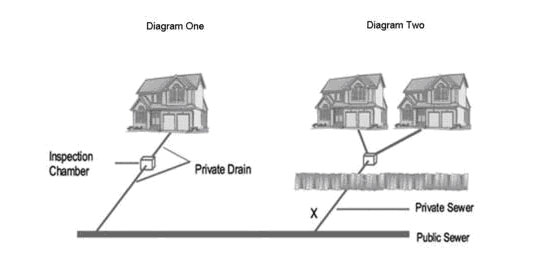From Norfolk County Council website
Sewers
When a drain serving one property joins with a drain from another property, the shared pipe is known in law as a sewer. Where the premises were built before 1 October 1937 the sewer is nearly always a public sewer. Those built after that date are usually private sewers.
Responsibilities for unblocking or repairing problem sections of foul sewage systems depend upon whether or not the sewer is classed as private or public. However this is not always easy to determine.
Private sewers (ie built after 1937)
These are maintained jointly by the owners of the properties which they serve. So the owner of a post-1937 property would be wholly responsible for their own drain and, if that drain does not connect directly to a public sewer (probably the main sewer under the road), they would share a further responsibility with other owners for a private sewer, up to its connection onto the public sewer.
Each owner is only responsible for sharing the maintenance of the private sewer downstream of their connection into it. For example, a blockage at the downstream end of a private sewer serving a terrace of houses should be cleared and paid for jointly by all of the owners, while a blockage at the upstream end would fall only to the two owners at that end. If the owners cannot clear the blockage themselves then they need to call in a drain cleaning company.

Diagram one
Your household drain may flow straight into a public sewer. If a blockage occurs anywhere in this private drain, you have sole responsibility for cleaning any blockages or carrying out any repairs. Most properties have some length of private drain.
Diagram two
Drains from two properties may join together and form a private sewer and then run some distance before connecting with the public sewer. If a blockage or defect occurs at point X in the private sewer system, the owners of the two properties would be responsible for rectifying the problem. It is important to note that the boundary of the property does not indicate the end of responsibility. This extends up to, and includes, the connection with the public sewerage system.
Any company employed to clear the blockage would probably want to be paid by just one person - that person would need to recover for themselves any contributions from the other owners. If one owner refuses to pay their share then the others would have the right to claim it back through the courts if necessary - but this is a private matter for the owners to decide as best they can. It may be worth checking title deeds to see whether they set out specific arrangements for maintaining a private sewer, such as by everyone paying a service charge to an agent to act on their behalf.
Public sewers (ie built before 1937)
These are maintained free of charge by Anglian Water. The fact that a sewer is located under a public road does not mean that it is a public sewer. Similarly, some public sewers can be found within the grounds of a privately owned home. Telephone 08457 145 145 to speak with a customer services agent at Anglian Water.

Diagram three
This shows how all the drains from a block of houses may link up before running into a public sewer. In some cases the drains from an entire estate may join a private sewer system before linking up with the public system and this could be some considerable distance.
Present legislation dictates that the owners or occupiers of homes above the point of the blockage or defect - whichever property's effluent flows through that point - are responsible. Therefore a blockage at point Y would only involve properties four, five and six. A blockage at point Z would involve all six properties.
Identifying drains and sewers
Where it is not known whether a pipe is a drain, a public sewer or a private sewer, owners could consider requesting Anglian Water to attend. If Anglian Water find it is a public sewer they would clear it free of charge. If they find it is private they might offer to clear it for a fee, though they are not obliged to.
Conducting works on drains and sewers
Please note that all new drainage work and repairs to existing drainage must comply with the Building Regulations. Before commencing any new work or repairs please contact North Norfolk District Council's Building Control Services for advice or to arrange any inspection and approval that may be needed (this would not be necessary just to clear a blockage). They also hold copies of original building plans for many properties and can often provide a date of construction over the telephone to help a quick decision about whether a sewer is public or private.
For further guidance on preventative maintenance to sewers please see Anglian Water's website.
Also see Anglian Water Guide Here>>
| 












